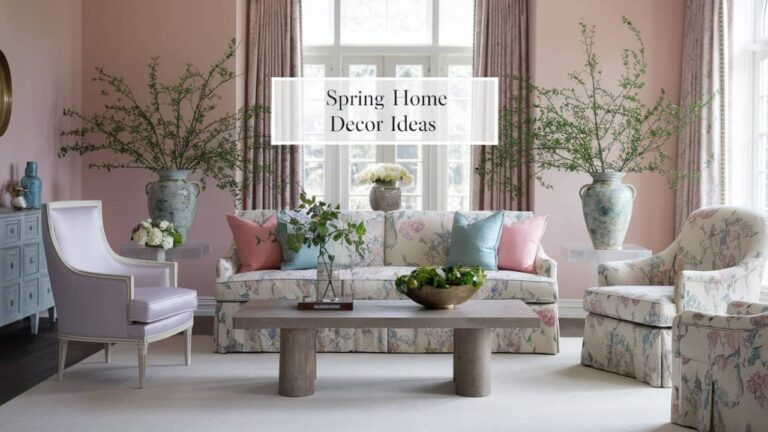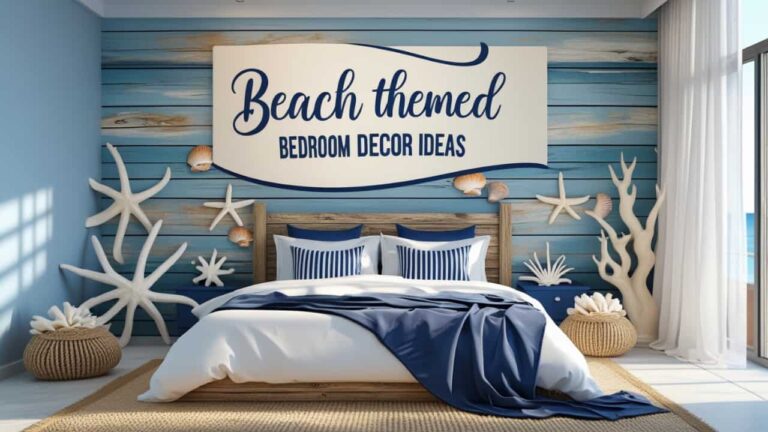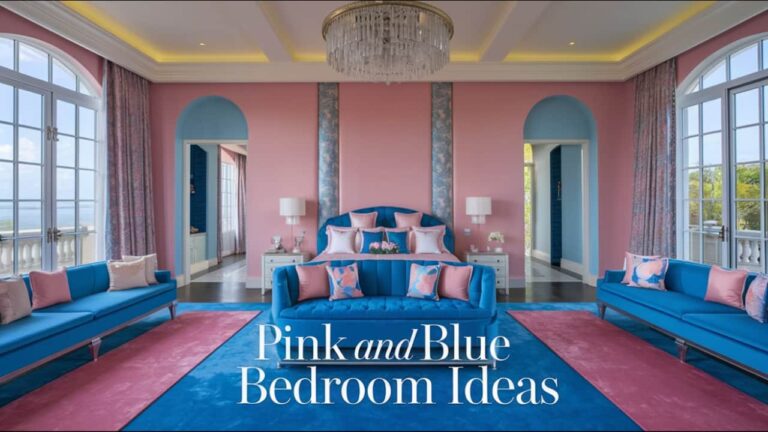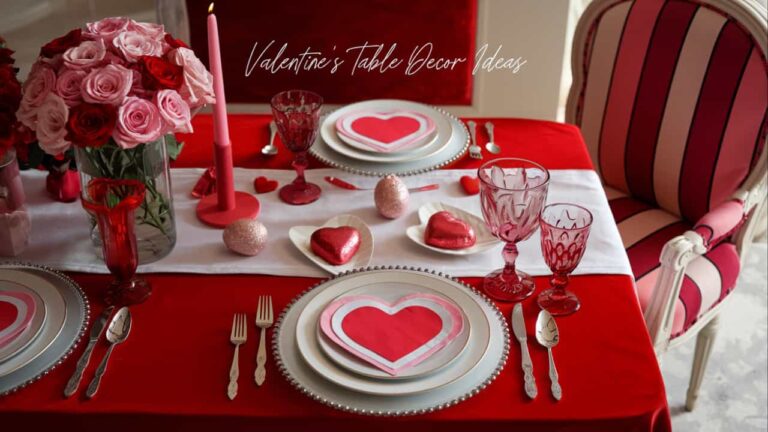Mid Century Living Room Ideas: A Stylish Blend of Vintage and Modern Comfort
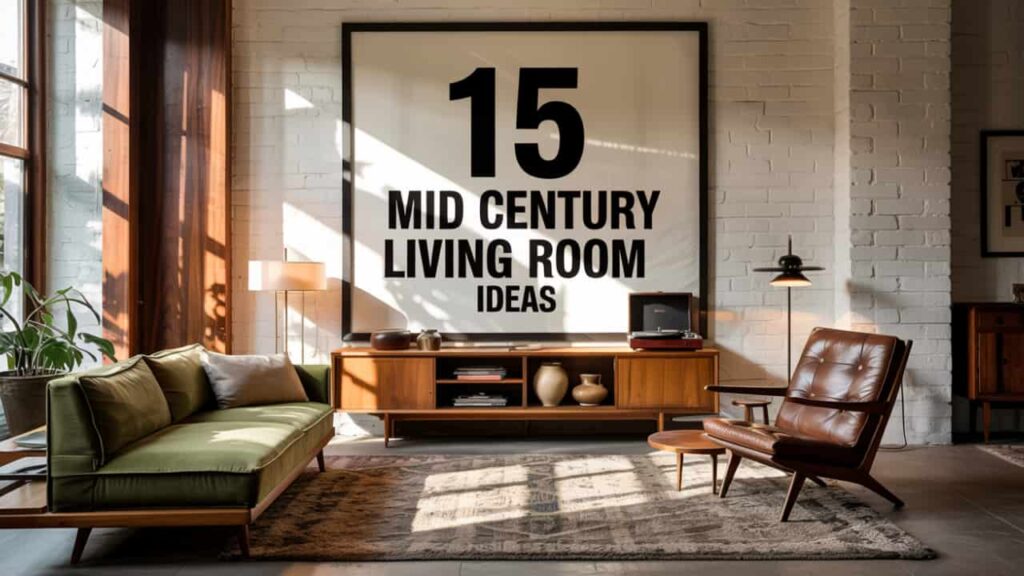
Mid-century modern design is more than just a style—it’s a celebration of timeless elegance, functional simplicity, and sophisticated warmth.
Originating in the post-war era of the 1940s through the 1960s, this iconic design movement reflects a cultural shift toward minimalism, clean architectural lines, and a seamless blend of indoor and outdoor living.
Today, Mid Century Living Room Ideas have made a powerful comeback, offering homeowners a chance to bring both nostalgic charm and sleek, contemporary appeal into their living spaces.
In this article, we’ll explore 15 carefully curated mid-century living room ideas to help you transform your space.
Whether you’re planning a complete overhaul or looking to add subtle vintage touches, these ideas will help you create a living room that feels effortlessly refined, practical, and endlessly inspiring.
1. Use Streamlined Furniture with Tapered Legs
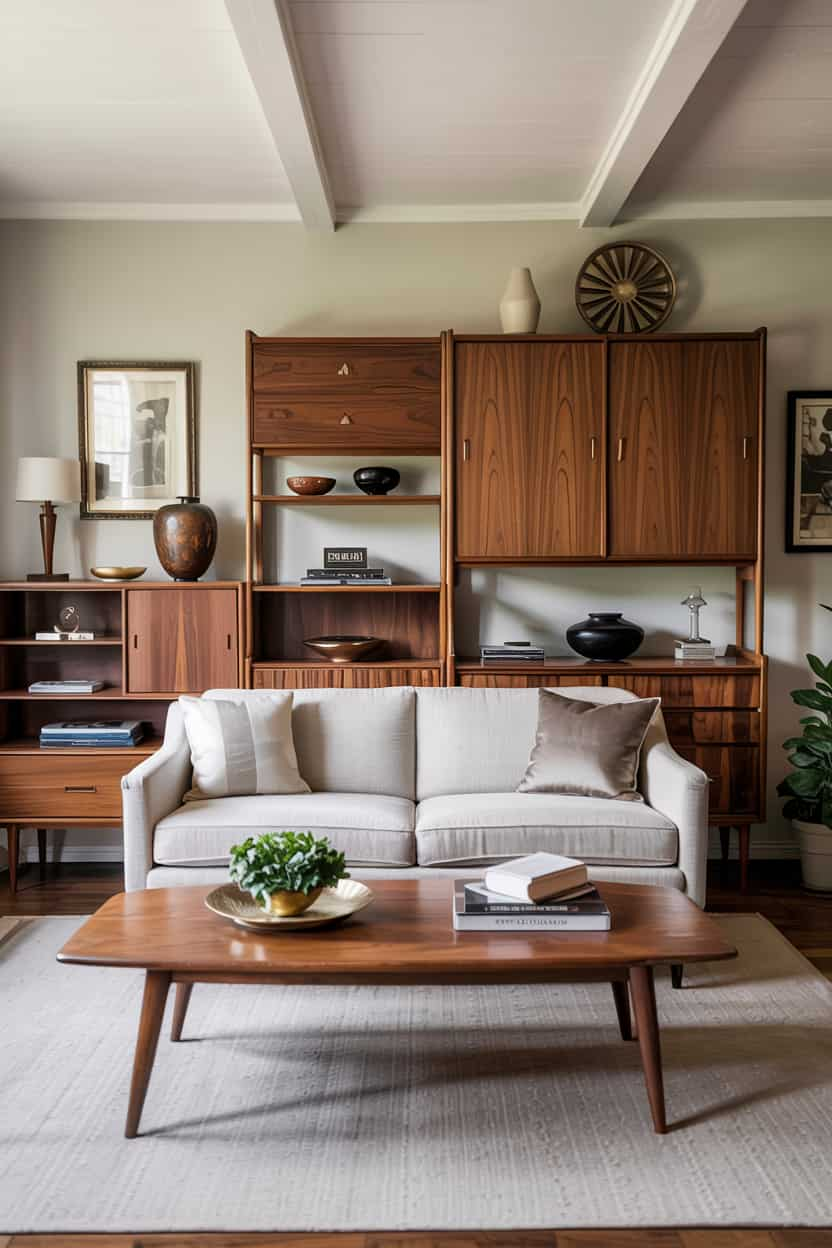
Mid-century design is known for its elegant simplicity, and nothing reflects that better than streamlined furniture with tapered legs.
These low-profile pieces, often crafted from walnut or teak, create a sense of openness by elevating the furniture off the floor.
Sofas and chairs typically have clean, boxy shapes with minimal ornamentation, offering both comfort and visual clarity.
Upholstery in natural fabrics like linen or wool complements the look while adding texture.
Pair your main seating with a matching coffee table or media unit to keep the design cohesive.
The visual lightness helps smaller rooms feel more spacious and breathable. Avoid bulky or overstuffed pieces that disrupt the clean-lined aesthetic.
The goal is to keep every item functional, stylish, and free from unnecessary embellishment.
2. Create a Retro Color Palette
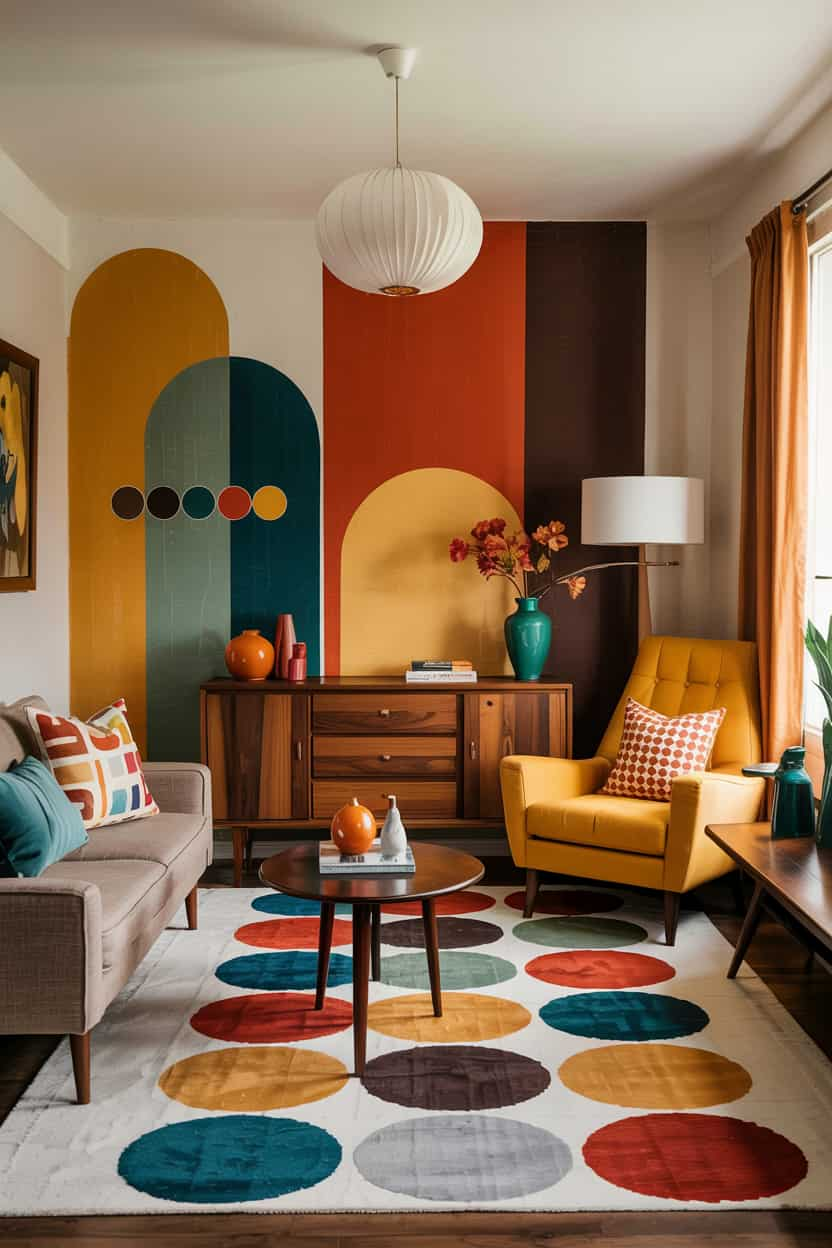
A vibrant yet balanced color palette is essential in achieving an authentic mid-century look.
Classic tones include mustard yellow, avocado green, burnt orange, teal, and brown, all inspired by nature.
These rich shades add warmth and personality to the room when layered over neutral walls in white, cream, or gray.
To avoid visual clutter, limit the bold hues to accessories like cushions, rugs, or a statement armchair.
Consider blending warm and cool tones to create contrast and depth. Color blocking is a popular mid-century trick that adds structure and style.
Pair vibrant elements with sleek wood finishes to ground the palette. This retro mix instantly infuses your living room with charm and character.
3. Incorporate Iconic Mid-Century Furniture Pieces
![]()
One of the defining features of mid-century design is its iconic furniture—pieces that are functional works of art.
Think Eames lounge chairs, Saarinen tulip tables, and Noguchi coffee tables, which bring history and sculptural beauty to any room.
These timeless designs provide strong visual anchors and reflect your appreciation for design heritage.
While originals are investment pieces, quality replicas offer the same flair on a budget.
Place these icons in areas of focus where they can shine, such as near a window or at the center of a seating area.
Let their shape and materials influence your surrounding decor. Avoid mixing too many styles in one space to maintain visual harmony.
These pieces add authenticity and elegance without overwhelming the room.
4. Embrace Natural Materials

Natural materials are the soul of mid-century interiors, infusing warmth and grounding energy into the space.
Teak, walnut, and oak are popular wood choices for furniture, shelving, and paneling. Leather, wool, linen, and rattan are commonly used for upholstery, cushions, and accent decor.
These textures offer both visual interest and a tactile quality that balances sleek furniture lines.
Avoid synthetic or overly polished finishes—embrace patina, visible wood grain, and imperfect edges.
Incorporate handcrafted accessories like ceramic vases or clay planters for a personal touch. Natural stone or terrazzo can also be introduced subtly in tables or flooring.
The connection to organic elements creates a cozy, calming atmosphere. A living room rooted in nature never goes out of style.
5. Layer with Geometric Patterns

Geometric shapes are a signature element of mid-century aesthetics, bringing rhythm and energy into the living space.
From area rugs with bold angular motifs to throw pillows covered in abstract prints, these designs are eye-catching without being overwhelming.
Stick to a consistent color palette to keep the patterns from clashing. One statement piece, such as a rug or curtain panel, is often enough to make an impact.
Pair geometric patterns with solid-colored furniture to create balance and cohesion.
Wall art featuring mid-century shapes—starbursts, circles, or linework—can add vertical interest.
Think of patterns as accents, not the focal point. When used intentionally, they give your space that iconic retro vibe with a modern edge.
6. Statement Lighting That Doubles as Art
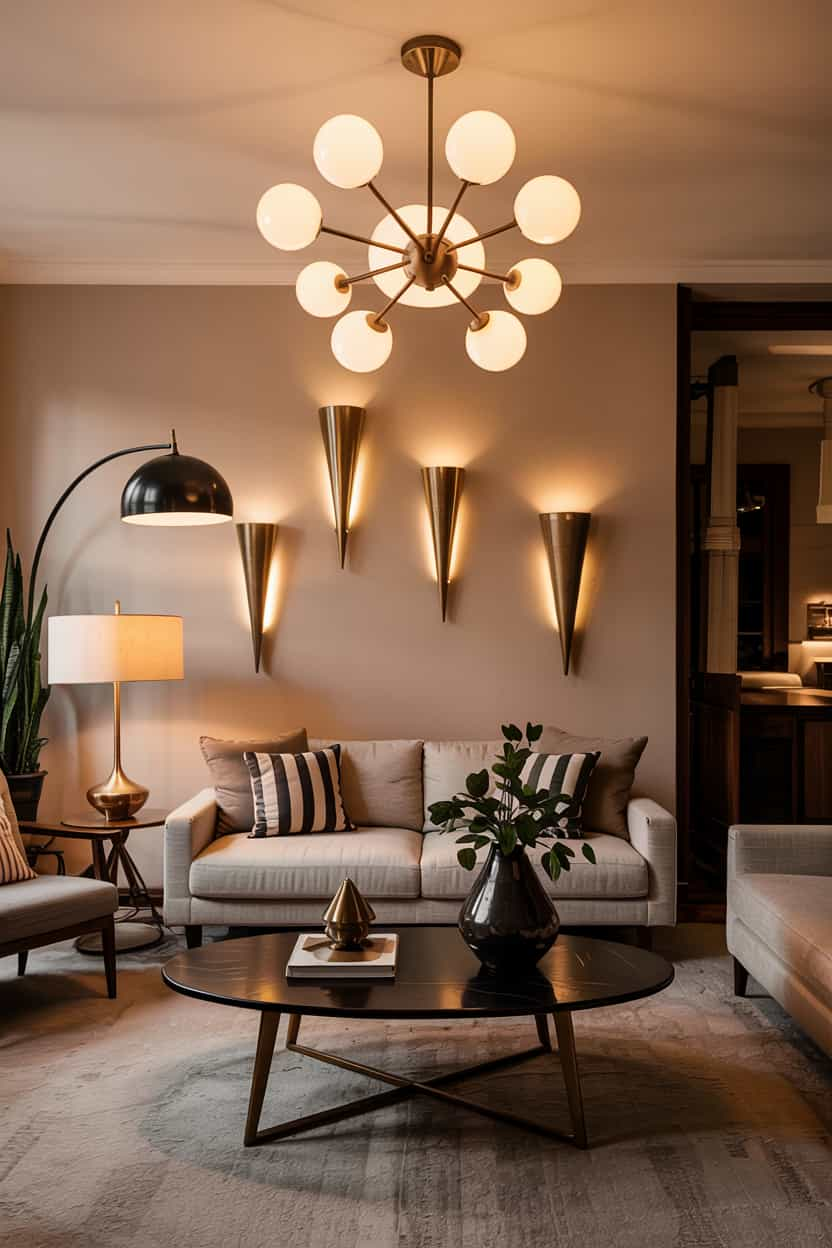
Lighting in mid-century modern design isn’t just functional—it’s a visual statement.
Iconic fixtures like sputnik chandeliers, globe pendants, and arc floor lamps serve as sculptural centerpieces that define the room’s character.
Choose finishes in brass, matte black, or polished chrome for a vintage feel with a modern twist.
Position these lights strategically over a coffee table or seating area to draw attention.
Wall sconces in cone or funnel shapes add layered illumination without taking up floor space.
The lighting design should complement your furniture’s lines while providing warm, ambient light.
Avoid overly ornate fixtures, which clash with the clean aesthetic. Instead, let the shape and structure of the light fixture become part of the decor.
7. Open Floor Plan with Defined Spaces
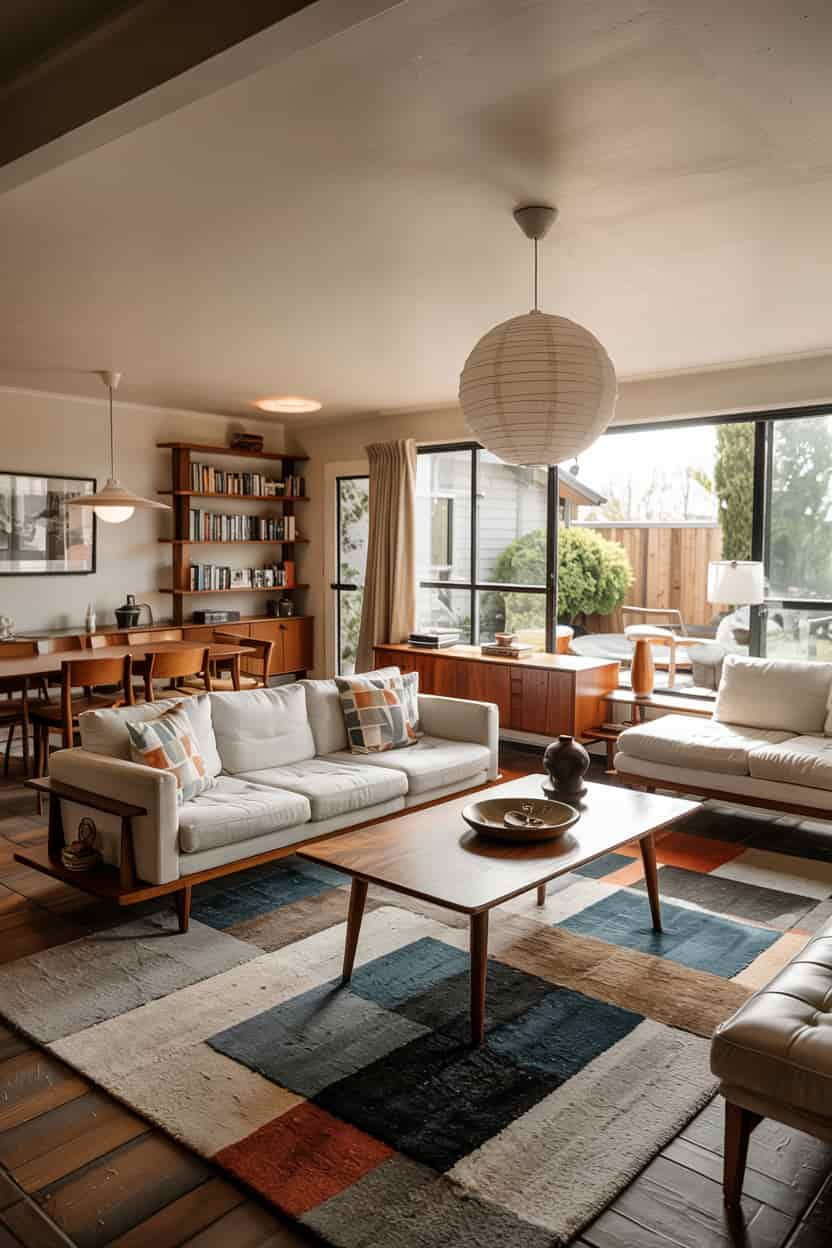
Mid-century homes often embraced an open-concept layout that encouraged flow and social interaction.
While keeping the space open, it’s important to define each area clearly—especially in multi-functional living rooms.
Use rugs to visually zone your seating area or place a bookshelf as a subtle room divider. Low-profile furniture helps preserve sightlines and a sense of spaciousness.
Maintain balance by centering major furniture pieces and creating conversation-friendly arrangements.
A cohesive color palette across different zones enhances harmony. Lighting can also be used to separate dining and lounging areas effectively.
The key is to allow natural transitions without making the room feel disconnected or cluttered.
8. Mix Vintage Finds with Modern Touches
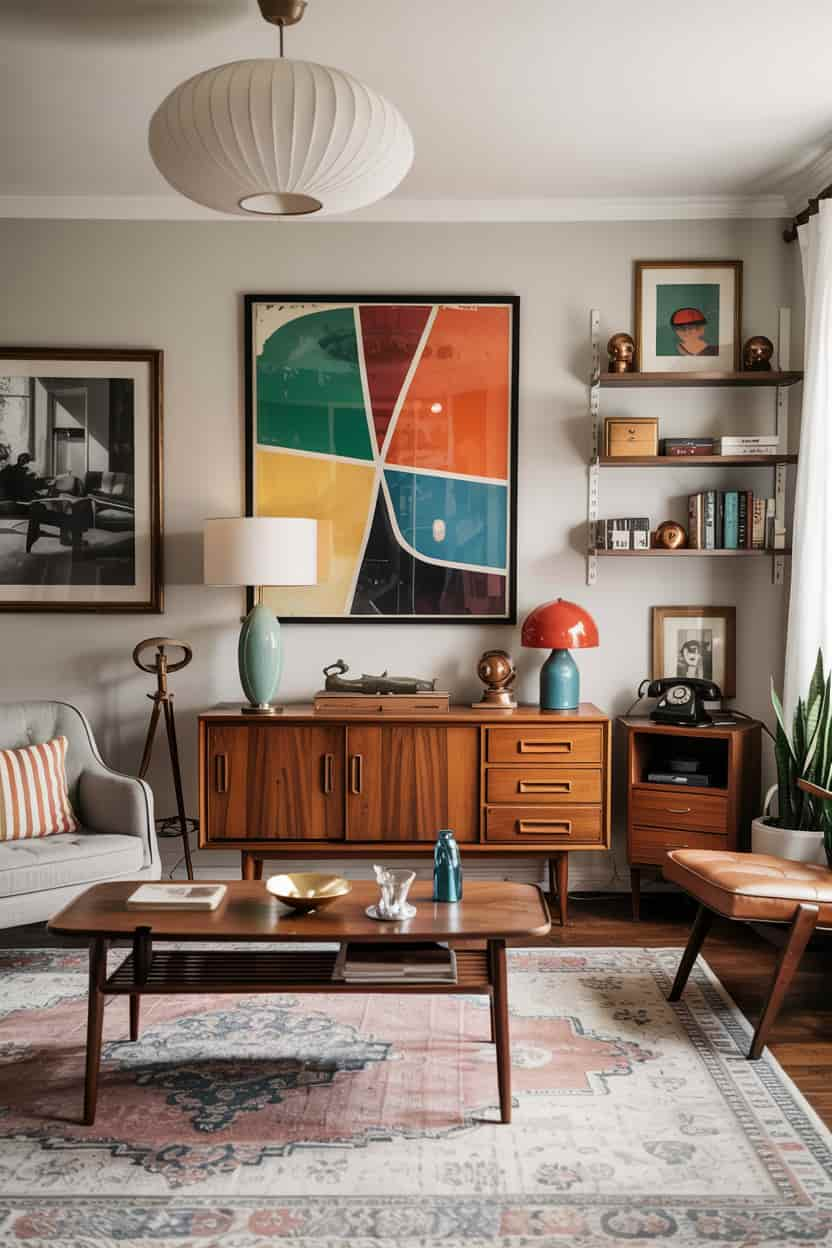
Blending old and new is at the heart of successful mid-century design. Authentic vintage items—like a teak sideboard, rotary phone, or 1960s artwork—bring depth and storytelling to the room.
Balance these retro treasures with modern accents to keep the space current and livable.
For example, pair a vintage coffee table with a contemporary sectional or mix a retro lamp with clean-lined open shelving.
The juxtaposition creates interest and ensures your space doesn’t feel like a time capsule.
Look for quality vintage pieces at estate sales or online marketplaces. Choose items with patina and character but avoid excessive wear.
The fusion of eras creates a curated, personal atmosphere that feels both grounded and fresh.
9. Let in Natural Light
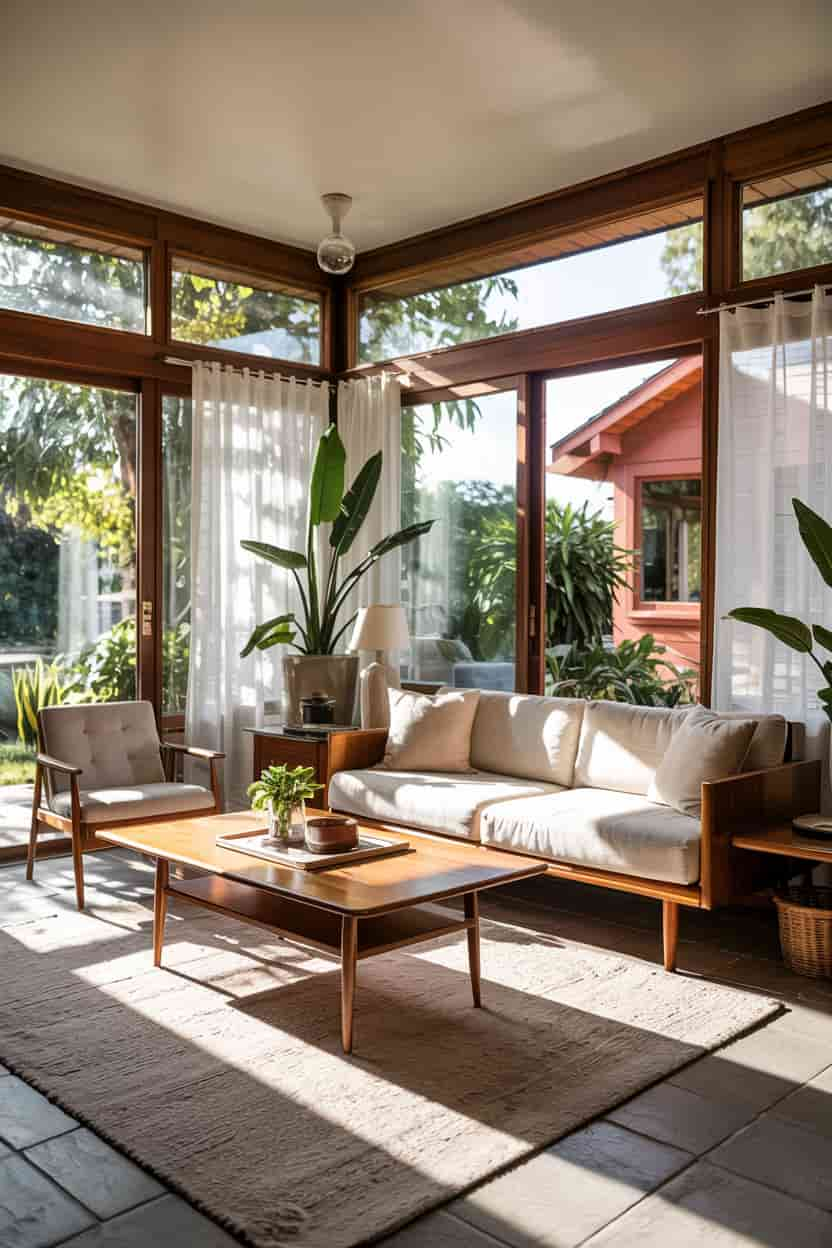
Mid-century living rooms are deeply connected to the outdoors, making natural light an essential design element.
Large windows, glass doors, and minimal window treatments help bring the outside in.
If your space lacks expansive windows, use mirrors to bounce light around the room and make it feel brighter.
Choose sheer or light linen curtains instead of heavy drapes to maintain openness. Position furniture to take advantage of daylight and avoid blocking windows with bulky items.
Adding a few indoor plants near light sources enhances the organic aesthetic. Natural light highlights the warmth of wood and texture in textiles.
Embracing the sun’s presence adds life, softness, and dimension to your mid-century layout.
10. Use Modular Storage Solutions
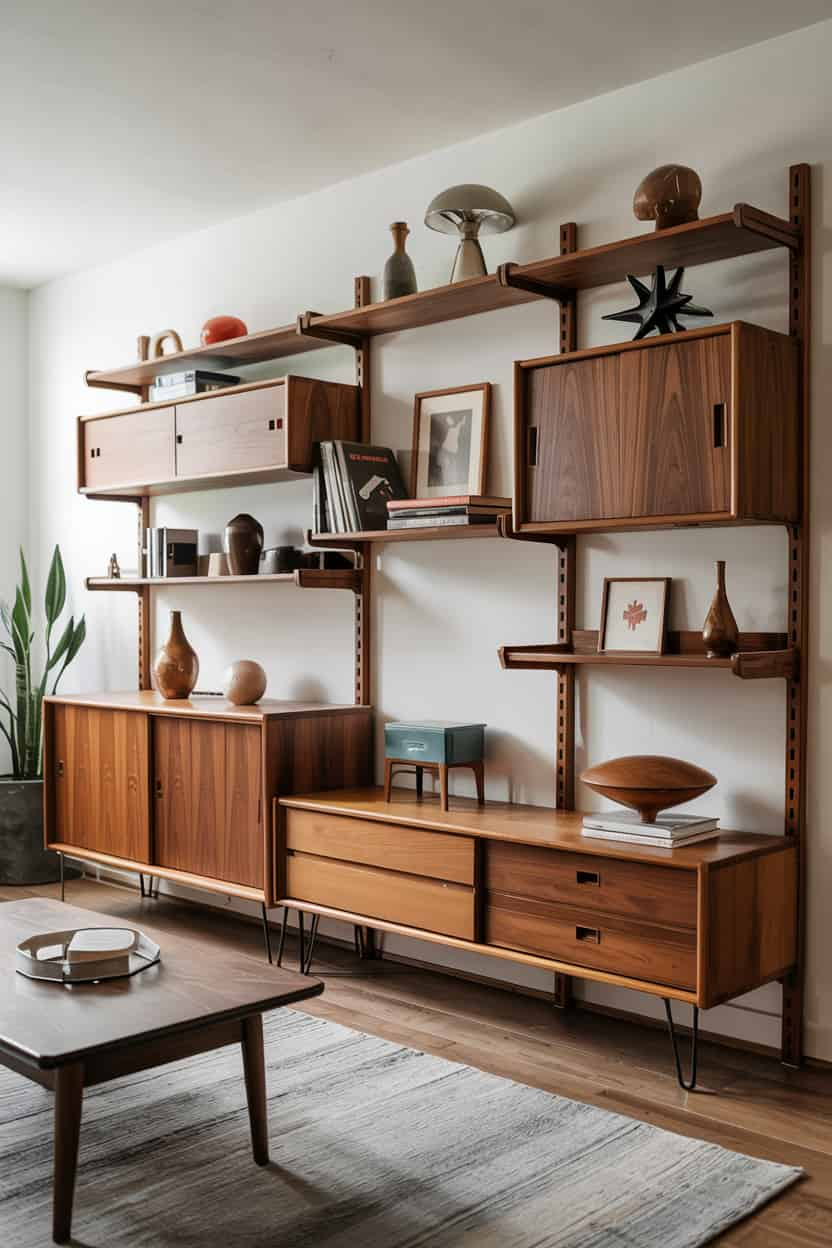
Storage in mid-century interiors is functional and stylish, often appearing as modular systems or floating shelves.
These units not only help keep your space tidy but also contribute to the architectural rhythm of the room.
Look for wall-mounted cabinets or open shelving that blends into your design seamlessly. Teak, walnut, or oak finishes ensure visual cohesion with the rest of your furniture.
Consider using record cabinets, sliding-door consoles, or media units with hairpin legs for both style and utility.
Floating bookshelves can display decor items without crowding surfaces. Opt for minimal hardware to preserve the clean aesthetic.
Thoughtful storage keeps your living room feeling organized, open, and intentional.
11. Bring in Mid-Century Wall Art
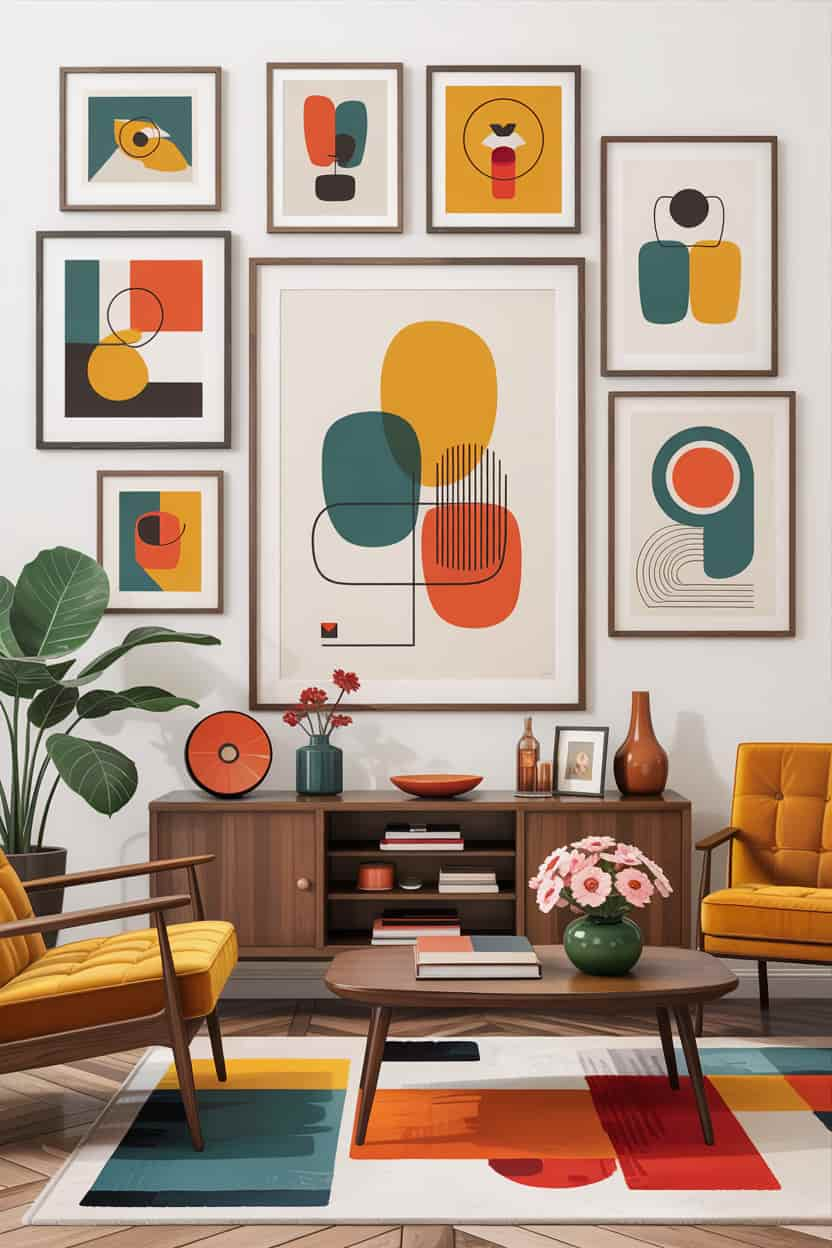
Mid-century wall art emphasizes abstract forms, minimalist compositions, and bold use of color.
Look for pieces featuring geometric shapes, line drawings, or vintage prints in retro tones like mustard, teal, and burnt orange.
Large-scale artwork makes a strong impact when hung above a sofa or credenza.
For a gallery feel, group smaller framed pieces in clean grids with consistent spacing and neutral frames.
Consider using wood, brass, or black metal frames to match your other mid-century finishes.
Avoid overly ornate or overly modern art that clashes with the era’s aesthetic.
Instead, keep the vibe playful, balanced, and slightly nostalgic. The right art can subtly tie together your room’s palette and mood.
12. Prioritize Functional Layouts
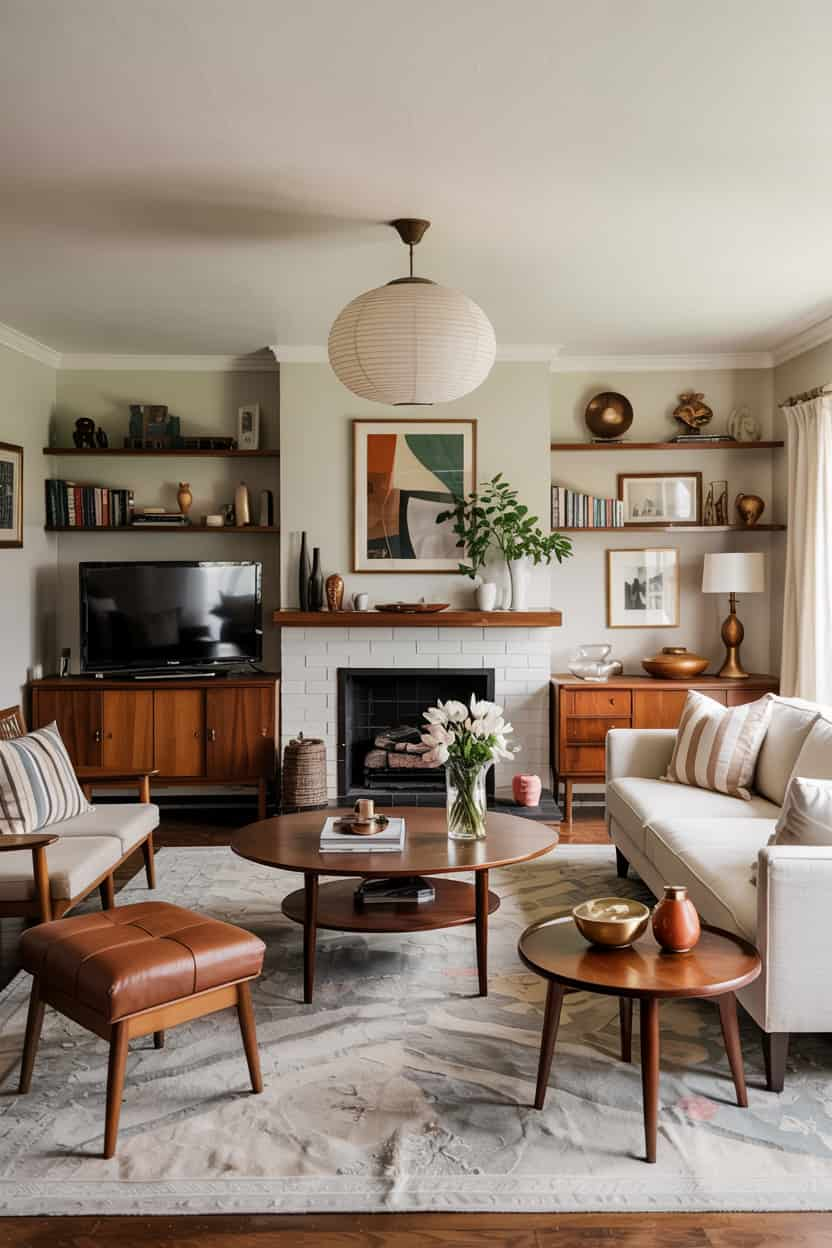
Function is a guiding principle in mid-century living room design, where every item should serve a clear purpose.
Start by arranging furniture around a central focal point, such as a fireplace, TV, or coffee table.
Leave open pathways between pieces to ensure easy movement and natural flow.
Choose furniture with built-in storage or pieces that can serve multiple functions, like nesting tables or an ottoman with hidden space.
Avoid overfurnishing—each item should have breathing room and intention. Keep accessories minimal to maintain visual clarity.
Thoughtful layouts make small spaces feel larger and more livable. Mid-century design celebrates simplicity and livability without sacrificing style.
13. Decorate with Retro Accessories
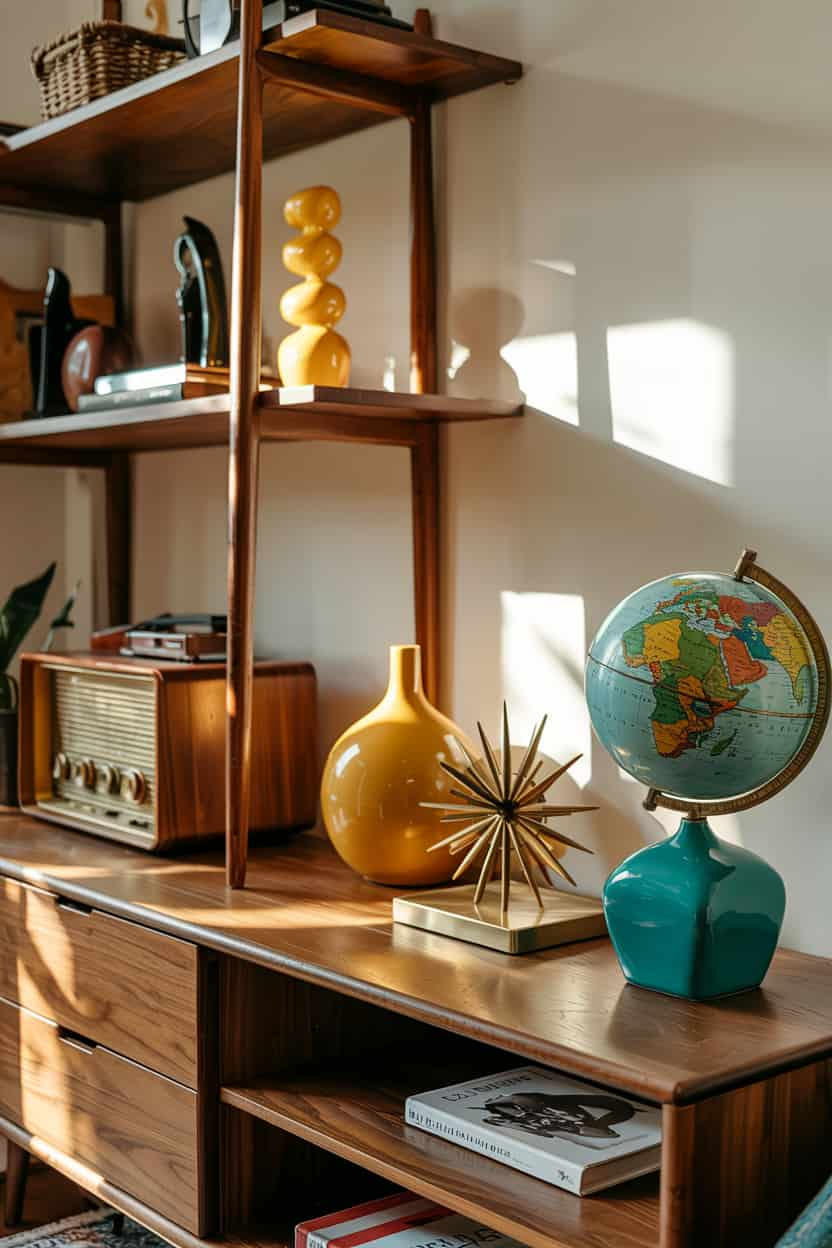
The finishing touches of a mid-century living room often come from nostalgic accessories that capture the spirit of the 1950s and 60s.
Think ceramic vases, starburst clocks, vintage globes, retro radios, and sculptural bookends.
These accents should feel curated, not cluttered—choose a few bold pieces that express your personality and tie into your color scheme.
Display them on open shelving, consoles, or coffee tables with clean styling. Avoid mixing too many patterns or themes; consistency is key.
Incorporate texture with woven baskets or macramé wall hangings for added depth.
These retro touches complete the story of your space and make it uniquely yours.
Balance nostalgia with a modern twist for lasting appeal.
14. Focus on Symmetry and Balance
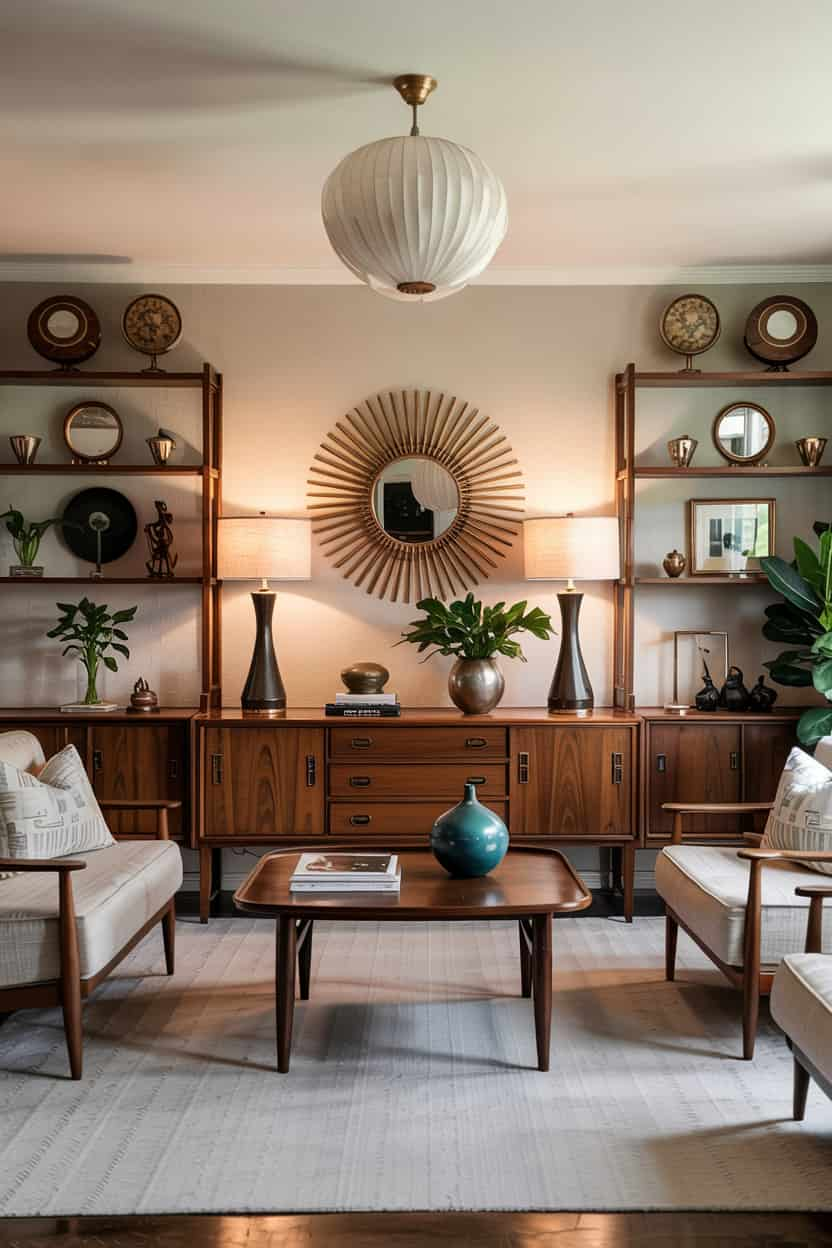
Mid-century interiors thrive on symmetry and visual balance, creating rooms that feel calm, cohesive, and intentional.
Start with major pieces—like a sofa flanked by matching armchairs or lamps on either side of a credenza.
Repeat shapes or finishes (like circular mirrors or brass hardware) throughout the room to create harmony.
Use symmetry in shelving arrangements or wall art layouts to bring order and rhythm.
This doesn’t mean everything must be identical—just evenly weighted across the room. Avoid placing all furniture on one side or corner.
Symmetry makes the space feel grounded and thoughtfully designed. When in doubt, step back and adjust for visual equilibrium.
15. Choose Rugs That Complement and Ground
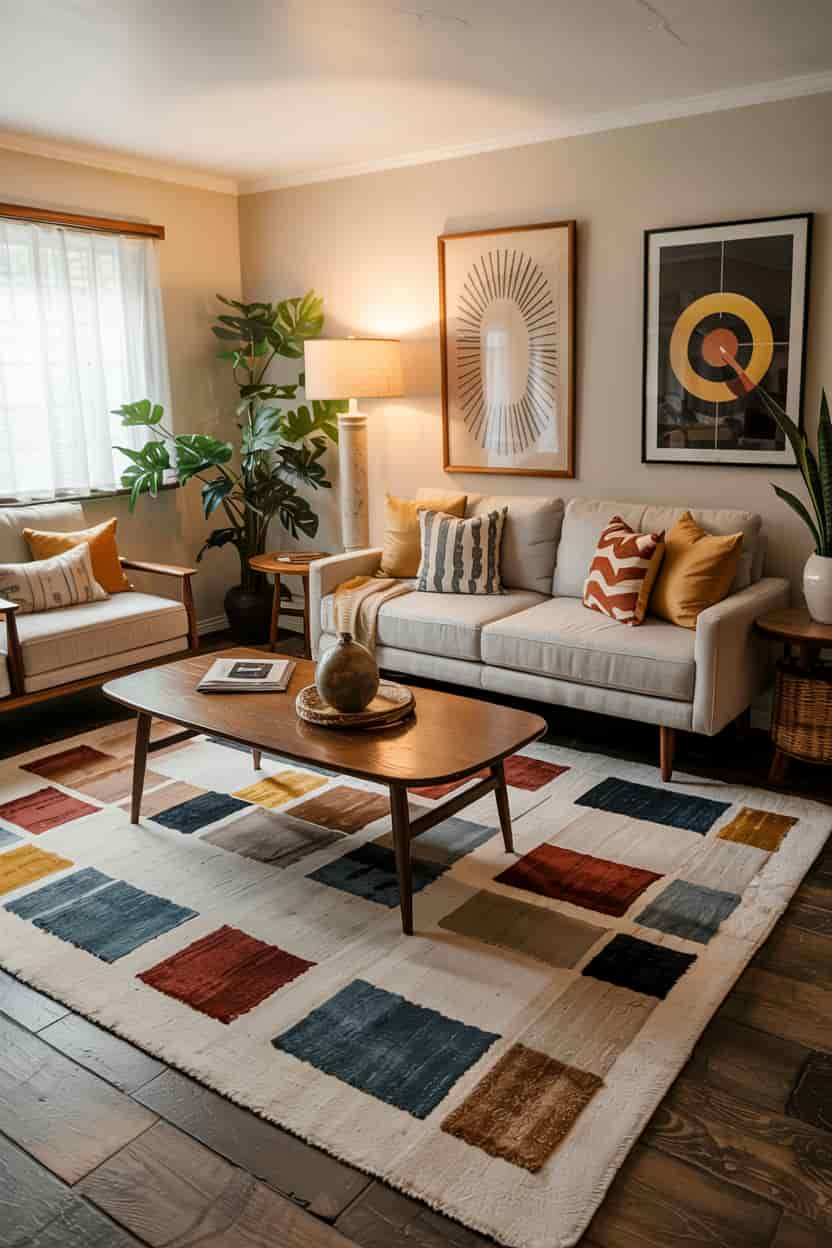
Rugs in mid-century living rooms serve as anchors that define zones and pull the room’s elements together.
Opt for geometric patterns, color-blocked designs, or solid shades in natural textures like wool or jute.
Look for rugs with low to medium pile to maintain the clean-lined aesthetic.
A rug should be large enough to sit under at least the front legs of all furniture pieces in the main seating area.
Choose colors that complement your accent tones or wood finishes to ensure cohesion. Patterns can add energy, but balance them with more neutral furniture.
Rugs also provide warmth and softness underfoot. They help frame the layout and create a finished, inviting look.
Useful Articles:-
- 25 Must-Have Mid-Century Modern Decor Accessories for a Chic Home
- 15 Modern False Ceiling Design Ideas for a Luxurious Home Interior
- 12 Modern Window Treatment Ideas for a Stylish Home
- Top Facade House Design Ideas to Make a Lasting First Impression
- Modern Mexican Home Decor Ideas: Add Vibrancy to Your Home
Conclusion:-
Designing with Mid Century Living Room Ideas is about striking a perfect balance—combining iconic vintage aesthetics with modern comfort. Whether you’re layering textures, playing with colors, or curating meaningful vintage pieces, each element adds to a space that feels both nostalgic and relevant.
With these 15 ideas, you can transform any living room into a stylish haven that channels mid-century charm while embracing the needs of today’s lifestyle. Clean lines, warm woods, purposeful layout, and statement decor will help your space feel thoughtful, elegant, and endlessly inviting.
